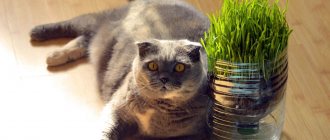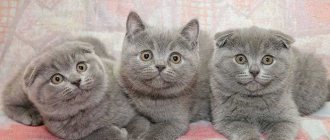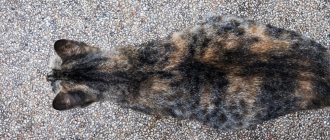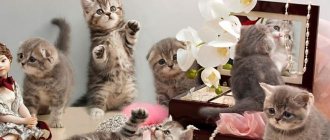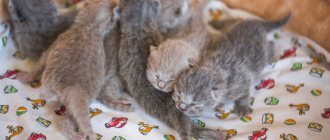Which cats may need obstetric care?
As already noted, cats require obstetric care extremely rarely. The process of giving birth to kittens most often occurs naturally and without any problems.
- Weakness of labor can most often be observed in older cats (over 7-9 years old) and in a British cat that is overweight.
- Disturbances in the course of labor often accompany those who have been ill during pregnancy, as well as those in a state of recovery after any serious illness.
- Monitoring childbirth is strictly indicated if the woman in labor has a history of any cardiac and/or pulmonary pathologies before pregnancy, as well as viral infections during pregnancy. In the future, it is better not to breed such cats anymore.
- In a Scottish cat, childbirth is often hectic, regardless of whether it is the first or not, so the presence of the owner at the most important moment is very desirable. In this breed, special attention should be paid to the selection of a cat due to the large variation in animal sizes. If a small Scottish cat is paired with an overly large cat, then obstetric care is guaranteed, and maybe even a caesarean section.
- Artificially bred cat breeds often lack maternal instinct, so owners often have to take responsibility not only for giving birth, but also for raising kittens. Sometimes this also occurs in fold-eared cats.
First signs of cat pregnancy
Once pregnant, a cat often becomes lethargic and drowsy. In the first 10 days, morning sickness is possible. The animal's behavior changes; it can become either aggressive or overly affectionate. Appetite increases, taste preferences may change. The nipples turn pink and swell, this becomes especially noticeable by day 21.
Two weeks after mating, the veterinarian can determine pregnancy by palpation or ultrasound. You cannot palpate the cat’s belly yourself (!), so as not to injure the embryos. If the mating was planned, it is recommended to immediately start a pregnancy calendar, which will help you adjust the diet at the right time and contact a veterinarian in time if the gestation period is delayed.
What you need to have on hand to help
A non-specialist is unlikely to be able to accurately determine whether in a given specific situation the help of a specialist is needed or whether independent participation will be sufficient. But if it is definitely decided to control the birth without a veterinarian, then the list of available materials should be as follows:
- surgical gloves (disposable or sterile) – 2-3 pairs;
- moisture-absorbing medical diapers (unscented) – 4-6 pieces, depending on size;
- a small waffle towel (clean, intensively ironed) - may be needed for resuscitation of a weak newborn baby;
- gauze or bandage wipes (sterile) – up to 2 packs;
- good cutting blunt scissors;
- surgical silk, catgut or any other surgical thread for tying the umbilical cord - sterile initially or soaked in alcohol on the eve of the expected birth;
- a small rubber bulb (syringe) – for pumping out mucus from the kitten’s airways;
- sterile petroleum jelly;
- hydrogen peroxide 3%, betadine or brilliant green solution;
- ammonia;
- a heating pad or electric sheet if the room is cool.
We recommend reading: What to do if your dog chokes on a bone and is choking, coughing, wheezing.
How to help a small or large dog. Only after consultation with a veterinarian (!) the following are added to the list:
- oxytocin;
- lauritin;
- calcium gluconate;
- disposable syringes - insulin and regular, 2 ml volume.
In general, consultation with a veterinarian is required! If a decision has been made to perform obstetric care on your own, then there must be a clear understanding of what is needed, why, and when the use of this or that material/drug will be appropriate.
Timing and duration
Now let's look at how long a cat's pregnancy lasts. As a rule, representatives of the Scottish Fold breed can carry offspring for 60 to 65 days.
The length of pregnancy depends on a number of factors:
- Weights. Large animals tend to bear kittens longer than normal, while small animals (up to 3 kg) sometimes give birth prematurely.
- Age. The first pregnancy, especially if the cat is not yet 1 year old, sometimes ends in birth after 50 days. This usually leads to the death of the offspring.
- Number of kittens. The more there are, the shorter the pregnancy will last.
- Health status. Illness and weakness of the animal can cause miscarriage.
Using the cat's pregnancy calendar, make sure that pregnancy does not prolong the pregnancy. If birth has not occurred on days 68–69, you must call a veterinarian.
Postnatal care
Half a day or a day after birth, you need to call a doctor to examine the mother. He will look to see if there are any more cubs in the womb and test the quality of the milk.
In the first 7 days, the animal’s temperature should be measured, if it is not lower than 39.4 C, this fact means there are problems. Postpartum discharge of blood or grass-colored fluid that lasts up to 3 weeks is considered normal.
If there is pus in them and they last longer than indicated, you need to contact a veterinary clinic.
A nursing pet should be walked only under supervision, because if she comes into heat and mates, she will become pregnant again, and this can significantly undermine her health.
Features of care and contraindications during this period
A pregnant cat requires the most careful handling. It is better not to pick her up; at least, hold her under her butt and breasts without touching her stomach. Medicines (even mild ones) can only be given as prescribed by a veterinarian. Worms cannot be removed at this time.
Similar article: Features of care and feeding of the Scottish fold cat
It is not recommended to let your cat outside to avoid injury and infection. It is important to protect her from drafts and hypothermia, to ensure that she does not climb onto high furniture, much less jump from there. Loud sharp sounds, turmoil or fright can cause a miscarriage, and if the term is late, on the contrary, a delay in labor. At this time, it is better to isolate the animal from small children.
Please note that a pregnant cat may go into heat. This happens due to living together with a cat or hormonal imbalance. At this time, re-fertilization is possible, but most often it ends in the death of either the “younger” litter or all the kittens. In rare cases, a cat gives birth to both “generations” in succession, but in this case she most often does not have enough milk. Therefore, if you have a couple of animals, it is better to keep your Scottish cat separately during pregnancy.
Another important question is what to feed a pregnant cat. At this time, you cannot transfer the animal from natural feed to industrial feed, and vice versa. Such a change in diet in itself is a burden for the body. When eating natural food, it is important that the diet contains a lot of protein: veal, dairy products, fish, eggs. Vegetables are also important. If you prefer to feed your pet commercial food, you need to choose a type specifically for pregnant and lactating cats.
Nutrition should include a full range of vitamins and microelements. Calcium is especially important. A veterinarian should select nutritional supplements. In the first weeks, food volumes should remain the same, but for weakened animals they can be increased by 10–15%. Gradually, meals are made fractional; by the middle of pregnancy, the frequency of feeding should reach 4–5 times a day. Initially, small portions are gradually increased. By the end of the period they should have grown approximately 2 times.
Similar article: A new friend or how to choose a Scottish fold kitten
For constipation, you can give your cat vegetable oil.
Possible complications
Childbirth does not always go flawlessly. Unforeseen and not very pleasant consequences may develop.
The cat cannot give birth to her first kitten
It happens that at the beginning of labor a problem arises with the very first baby. Perhaps the fetus is large, or its location is not normal. When the process has been going on for an hour, and the cat cannot give birth, it is necessary to urgently call a doctor.
If the baby gets stuck, the mother in labor will need help. In this situation, the cat owner must:
- Take Vaseline oil into a pipette and lubricate the birth canal.
- When the presenting part of the kitten appears, immediately press on the part of the perineum located below the anus.
- Grab the animal by the skin in the withers area (through a sterile cloth) and, while the cat is pushing, slightly pull it towards you.
- Gently hold the baby's head between your fingers;
- start shaking back and forth (like “chopping wood”), after every 3-4 shakes, rub the kitten’s chest, blow into the nose;
- Place the squealing baby next to the mother.
It is better to immediately place the successfully extracted animal in the mother's body; she will do the rest herself. If the Scottish cat does not lick the newborn, he needs to be wiped with a damp cloth, his nose and mouth should be freed of mucous masses using a small enema and placed back with the cat.
Dead kittens
If the newborn is not breathing, you can try to bring him back to life. The cat owner will have no more than 5 minutes to do this. If during this time the animal does not give a voice, further resuscitation will be useless.
The sequence of actions is as follows:
If the baby does not come to life, you can apply cotton wool with ammonia to his nose. The most radical way is to dip the kitten alternately in warm and cool water. This stimulates the heartbeat. The revived baby's nose and tongue turn pink.
It happens that a cat does not want to lick a child who has already been in the wrong hands. In this case, you need to take a piece of damp gauze, massage the baby's anorectal area to induce bowel movements, and place the baby again next to the cat.
The placenta did not come out
If after the birth the cat is in a nervous, restless state, there may be some placenta left inside. This can lead to the development of inflammatory processes and intoxication.
You should call a veterinarian as soon as possible. No animal owner can cope with this problem on their own.
Prolonged labor
If all the signs of the first stage of labor are observed, the animal is suffering, but does not give birth, despite strong attempts, the help of a doctor will be needed. The cat should be taken to the clinic as soon as possible and x-rayed.
Signs of prolonged labor are:
- absence of kittens 1–2 hours after the start of the process during strong contractions;
- the appearance of sudden weakness in a cat against a background of elevated temperature (40°C or more).
If bleeding starts and does not stop within 5–8 minutes, you should urgently call a doctor. The best option would be to transport the cat to a veterinary clinic.
Preparing for childbirth
Preparations for the birth of a Scottish cat need to begin in advance. A week before the approximate date, have a preventive examination with a veterinarian and arrange in advance for emergency care in case of need. Create as quiet and calm conditions as possible for your cat. Try to keep other pets away from her and do not allow children to disturb the animal.
Prepare a convenient box lined with old newspapers or blankets. Reward your animal for sleeping and resting inside. Bowls with food and water, as well as a tray, should be placed nearby. The box should be about 50x50x50 cm. An entrance is cut on one of the walls with a threshold 10–15 cm high so that the cat can easily climb inside, but small kittens have no way to get out.
You also need to prepare disposable diapers, scissors, alcohol for disinfection, thread, Vaseline and a heating pad in advance.
Preparatory stage
The owner of a Scottish Fold should prepare in advance for childbirth at home. First of all, noise, strangers and drafts should be excluded.
It is better to replenish the first aid kit in advance:
- surgical gloves;
- Vaseline;
- nylon thread;
- iodine;
- hydrogen peroxide;
- sterile wipes;
- 1 and 2 ml syringes;
- oxytocin;
- traumeel, gamavit, glucose (5%), ascorbic acid in injections.
The owner should always have clean towels, a heating pad, small sterile scissors, and a microenema on hand. You need to communicate with your cat calmly, kindly, without sudden movements. If the expectant mother decides that something threatens her, she can delay the onset of labor and quickly make a new nest.
Childbirth process
When a cat is preparing to give birth, her behavior changes noticeably. She regularly licks her crotch and breathes frequently. Representatives of this breed often try to attract the attention of their owners and achieve their presence near the box, often rubbing against their legs, meowing and purring.
It is advisable that the birth of a Scottish Fold cat take place under supervision. You should not interfere too actively in the process unless there is a clear need for it. If the contractions are weak, you can carefully pull the kitten towards you, after lubricating your hands with Vaseline. You need to hold him by the withers. If the cat does not expel the placenta on its own, it must be carefully pulled out.
The umbilical cord of a newborn kitten is tied with thread, disinfected and cut at a distance of 2 cm from the abdomen. The cat should lick and feed the baby, after which it can be placed on a heating pad covered with bedding. The average interval between the birth of kittens is 30–60 minutes.
Related article: How long do Scottish Fold cats live?
Factors that determine the number of kittens in a litter
For the convenience of readers, we have listed them in the form of a list below.
The first factor, which we have already mentioned, is age. Old cats (as well as very young ones) give birth to few kittens. This is a proven scientific fact.
The second factor is heredity. If the female herself belongs to a large litter, then her chance of bringing the same numerous offspring increases significantly.
The third factor is breed. If we discard exclusive cases, then purebred representatives of the cat kingdom differ from their outbred fellow tribesmen in being much less fertile.
The fourth factor is the conditions in which the pet is kept. This includes the cleanliness of the room, comfort, and the presence (or absence) of stressful situations.
The fifth factor is the cat's diet. It must be balanced and contain all the necessary microelements and vitamins. Proper nutrition will directly determine how many kittens a cat will give birth to and whether she will be able to get pregnant at all.
Factor six is the presence or absence of any diseases, especially infectious etiology. The normal course of pregnancy and the birth of healthy offspring by the cat depend on this.
All of these factors together have a huge impact on how many kittens a cat will give birth to. Also, the physiological characteristics of the male who will be used for mating have a huge impact on future offspring.
Newborns
During the first 21 days of life, normal cubs only feed on milk and doze. In most cases, the mother independently looks after the babies and their bed. After the first week, kittens begin to develop eyes. They begin to fully see the world around them by two weeks. All newborns have heavenly colored eyes.
It is replaced with a permanent one in the third month. Babies' ears open on the 5th-8th day after birth, and straighten after 2 weeks.
The fluffies try to get up from the age of 18 days, and after another four days they can walk. From now on, they can eat from a plate themselves. If possible, you should not disturb the kittens again before they learn to crawl, since the mother will worry if someone touches her babies.
It is believed that the Scottish baby, caressed by people, will not get along well with his mother and the entire litter in the future. But if there is no communication with a person at all, the animal may show fear and anger, and become a slob.
Birth
The beginning of this stage marks the appearance of the fetus. It is a bubble with light yellow liquid. A special fluid lubricates the birth canal to facilitate the process.
In a few minutes the next baby should appear. Typically, cubs are born head first, and then the body emerges from the mother's body.
The mother tears open the bubble surrounding the baby and licks it to clear the airways of fluid. The kitten takes its first breath and its lungs expand. The cub is now breathing on its own.
As a rule, the woman giving birth does everything necessary on her own. If she is not in a hurry, she should break the bubble so that the baby does not suffocate. You need to tear the shell from head to tail, then you should immediately pump out the liquid from the baby’s nose using a syringe or pipette.
When a newborn makes a squeak, you can be sure that he is breathing. Now it’s time to dry the kitten with a soft towel and return it to its mother.

